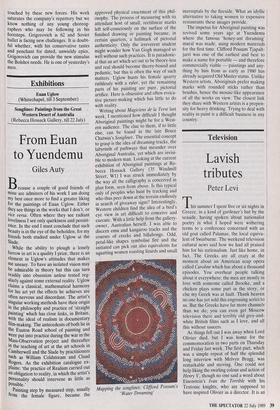Exhibitions
Euan Uglow (Whitechapel, till 3 September)
Songlines: Paintings from the Great Western Desert of Australia (Rebecca Hossack Gallery, till 22 July)
From Euan to Yuendemu
Giles Auty
Because a couple of good friends of mine are admirers of his work I am doing my best once more to find a greater liking for the paintings of Euan Uglow. Either they see things in the works that I don't, or vice versa. Often where they see radiant loveliness I see only quirkiness and persist- ence, In the end I must conclude that such beauty is in the eye of the beholden, for my friends both studied under Uglow at the Slade.
While the ability to plough a lonely furrow in art is a quality I prize, there is an element in Uglow's attitudes that makes me uneasy. To have an isolated vision may be admirable in theory but this can turn readily into obsession unless tested reg- ularly against some external reality. Uglow claims a classical, mathematical harmony for his art yet the effects he achieves are often nervous and discordant. The artist's singular working methods have their origin In the philosophy and practice of `straight Painting' which has close links, in Britain, With the ideal of realism in documentary film-making. The antecedents of both lie in the Euston Road school of painting and were put into practice during the war in the NI. ass-Observation project and thereafter in the teaching of art at the art schools in Camberwell and the Slade by practitioners such as William Coldstream and Claud Rogers. As the exhibition catalOgue ex- plains: 'the practice of Realism carried out an obligation to reality, in which the artist's Personality should intervene as little as Possible.'
Painting step by measured step, usually from the female figure, became the
approved physical enactment of this phil- osophy. The process of measuring with its attendant host of small, rectilinear marks left self-consciously on the surface of the finished drawing or painting became, in certain quarters, a hallmark of pictorial authenticity. Only the irreverent student might wonder how Van Gogh managed so well without such practices. It is paradoxic- al that an art which set out to be theory-less and real should become theory-hound and pedantic, but this is often the way of such matters. Uglow hunts his female quarry ruthlessly with a ruler, yet the remaining parts of his painting are pure, pictorial artifice. Here is obsessive and often evoca- tive picture-making which has little to do with reality.
Writing about Magiciens de la Terre last week, I mentioned how difficult I thought Aboriginal paintings might be for a West- ern audience. The clue to them, if to little else, can be found in the late Bruce Chatwin's Songlines. The essential concept to grasp is the idea of dreaming-tracks, the labyrinth of pathways that meander over Aboriginal Australia, yet which are invisi- ble to modern man. Looking at the current exhibition of Aboriginal paintings at Re- becca Hossack Gallery (35 Windmill Street, W1) I was struck immediately by the way all the calligraphy is conceived in plan form, seen from above. Is this typical only of peoples who hunt by tracking and who thus peer down at the terrain endlessly in search of giveaway signs? Interestingly, Western children find the idea of a bird's eye view in art difficult to conceive and execute. With a little help from the gallery- owner, Australian herself, I was able to discern emu and kangaroo tracks and the courses of creeks and billabongs. Odd, petal-like shapes symbolise fire and the initiated can pick out also equivalents for squatting women roasting lizards and small
Mapping the songlines: Clifford Possum's 'Water Dreaming' marsupials by the fireside. What an idyllic alternative to taking women to expensive restaurants these images provide.
The impetus for Aboriginal painting was revived some years ago at Yuendemu where the famous 'honey-ant dreathing' mural was made, using modern materials for the first time. Clifford Possum Tjapalt- jarri was one of the earliest and best to make a name for portable — and therefore commercially viable — paintings and any- thing by him from as early as 1980 has already acquired Old Master status. Unlike Western artists, Aboriginals prefer making marks with rounded sticks rather than brushes, hence the mosaic-like appearance of all the works on view. The closest link they share with Western artists is a propen- sity for heavy drinking. Trying to deal with reality in paint is a difficult business in any country.


















































 Previous page
Previous page